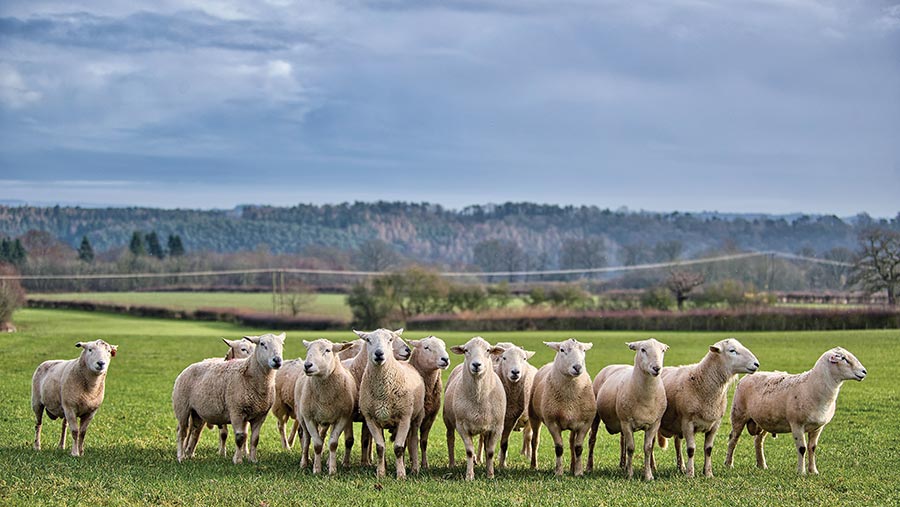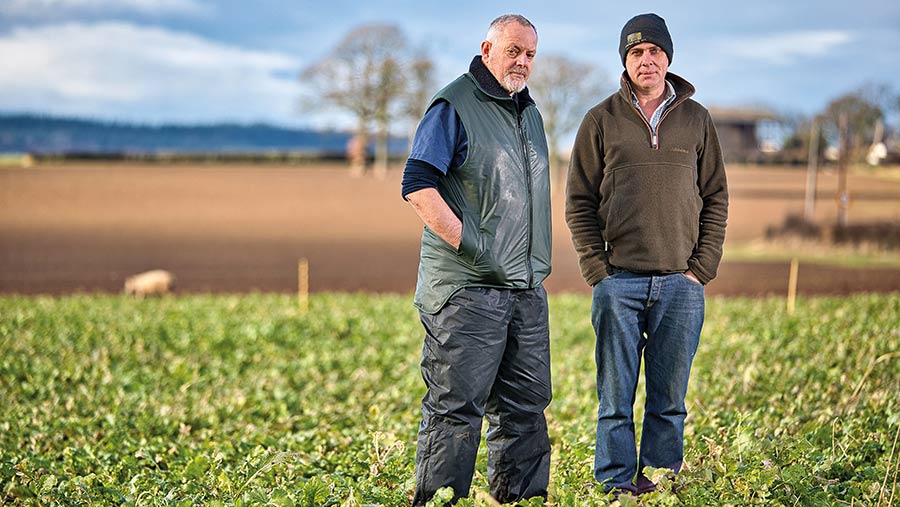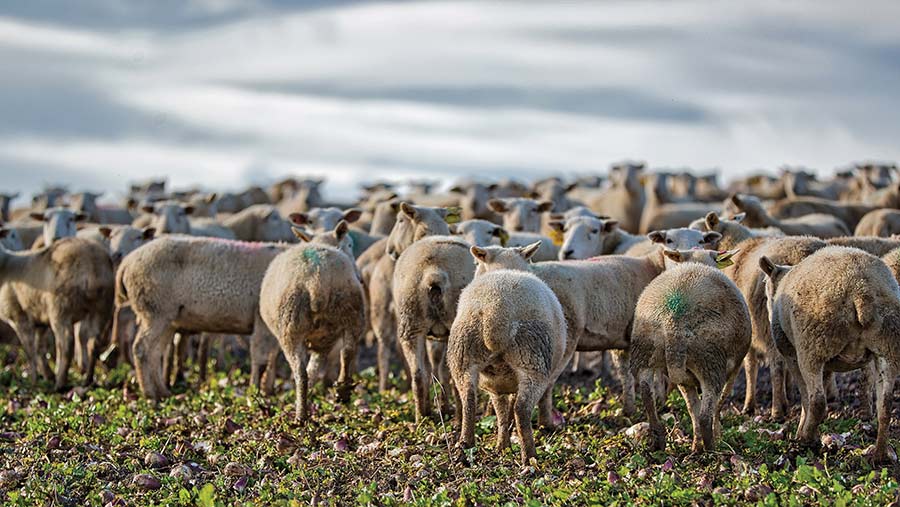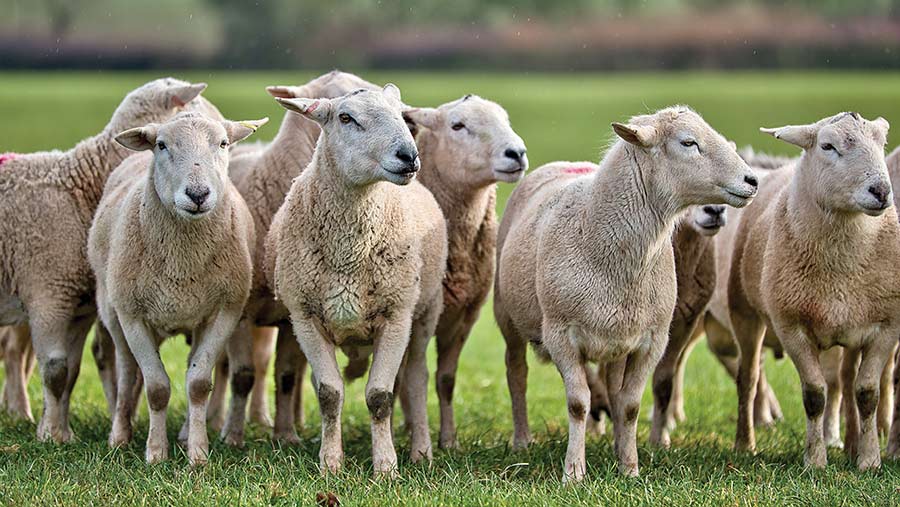How breeders are using methane test in wool-shedding project
 © Richard Stanton
© Richard Stanton A farming duo has added methane testing to its breeding programme in a quest to develop low-input sheep with low methane emissions.
Shropshire sheep and arable farmer Hayden Woolley and vet Ian McDougall artificially inseminated and naturally mated more than 1,200 EasyCare ewes to the best wool-shedding genetics they could find from the northern and southern hemispheres.
See also: Breeders step up hunt for wool-shedding genetics
They aim to produce low-input maternal and terminal composite shedding lines under their Low Footprint Lamb (LFPL) banner so they can sell breeding stock.
Farm facts: The Albynes, Bridgnorth, Shropshire
- Farms 688ha – 182ha owned and the rest rented from six landlords
- 4,000-head flock including 3,000 mature ewes and 1,000 ewe lambs
- High health-status flock
This season, they are expanding their genetic pool, having bought performance-recorded EasyCare ewes from Stephen Johnston, Northern Ireland; Barry Sangster, near Berwick-upon-Tweed; and Tom Welsh from Mossfennan.
The flock is being recorded on the New Zealand (NZ) database Sheep Improvement Limited (SIL), because the flocks will be closely linked to four shedding flocks in NZ, including Wairere.
These flocks and Mossfennan all use the database.
“We will be sharing semen, rams and embryos with these flocks.
It means LFPL will be able to tap into a wealth of performance-recording data on both sides of the equator and identify the best-performing genetics faster,” he explains.

Ian McDougall and Hayden Woolley © Richard Stanton
Results from 2022 progeny
Ewes were lambed outdoors for five weeks from late March. Lambs were recorded from birth and have been fed grass alone.
At eight weeks, lambs averaged 23.5kg based on a 4.6kg birthweight average.
“It is not fantastic, however, as the dry June stalled grass growth,” says Hayden, adding that progeny from the pure EasyCare ewes grew just as well as Texel- and Charolais-cross lambs used as a control.
“None of the lambs required tailing or castrating, and outdoor lambing naturally lowers antibiotics use.
“In addition, all ewes and lambs were farmed without routine fly treatment.”
Hayden believes these are important selling points given sheep farmers will have to farm without subsidy in the not-too-distant future.
Scald has been an issue with some purebred progeny (but not crossbred) from the Australian embryos imported last season.
In comparison, lambs bred from New Zealand genetics were unaffected.
“Foot-rot is a notifiable disease in Australia, so most Australian sheep’s feet have not evolved any defence mechanisms [to it], which leaves them naïve.
“In New Zealand, where foot-rot is endemic, lame sheep are culled rather than treated,” Ian explains.
The Australian White naturally has a very short tail and tail length is heritable, so if tailing lambs is banned, the Australian White may justify some level of inclusion into the terminal line, believes Hayden.
Investing in genetics
LFPL imported six new rams from NZ this year. Two of these are non-shedding NZ Texel shared with Easyrams.
These rams have each been mated to 100 ewes and have been used in artificial insemination programmes.
One of the NZ Texels is ranked highly for terminal traits, while the other scores highly for maternal traits.

© Richard Stanton
Since last year, the flock has been separated into three types: terminal shedding, maternal shedding and a Romney flock that is being graded up to a fully shedding flock retaining as much of the original Romney genetics and characteristics as possible.
The terminal flock comprises 500 larger EasyCare ewes (weighing 70kg on average), some of which carry the myomax gene.
These terminal shedding ewes have been mated to two recorded, UK shedding Texels (with small heads and good feet), one shedding NZ Texel and two NZ Texels with full wool.
“The NZ Texel rams with wool have traits [in particular, very high maternal breeding values] we believe UK shedding sheep need, and we think it’s worth taking a step backward by reintroducing some wool to include the improvements these animals offer,” says Ian.
“The wool can easily be removed with a second cross back to EasyCare or NZ Wiltshire.”
The maternal shedding flock comprises 1,000 EasyCare ewes, weighing 60-65kg.
These have been mated naturally to five NZ Wiltshire rams, five UK EasyCare rams and one woolly maternal NZ Texel.
Alongside this, 300 embryos, sourced from the ewes bought from Stephen, Barry and Tom, have been implanted, replicating this year’s NZ export.
The Romney flock has 1,200 ewes: 600 are kept on Hayden’s farm in Shropshire, and the other 600 belong to Brian Sankey and are based on his farm in Herefordshire.
NZ and British shedding rams have been introduced to the Romneys to begin the process of removing wool.
“We will be monitoring the effect on labour and sheep production.
“Half of the ewes in Brian’s flock will be tupped to pure NZ Romney, and half of Hayden’s ewes have been implanted with embryos frozen from previous Wairere exports. This should act as a sort of control group,” says Ian.

© Richard Stanton
Improved prolificacy
One of LFPL’s founding goals is to breed low-cost shedding sheep that lamb outdoors unassisted and wean 165% at 12 weeks with reasonable weaning weights.
To achieve this, they have imported NZ Wiltshire rams bred by Grant Keen, whose outdoor-lambing flock has lamb survival figures of more than 180% weaned.
They are also using a non-shedding NZ maternal Texel, which is highly ranked for maternal traits and carries what Ian terms a “secret weapon”.
“This ram carries one copy of the growth differentiation factor 9 (GDF) gene, which originates from Finnish Landrace sheep,” explains Ian.
It is believed the gene entered NZ in 1995 in Texel ewes from Finland.
One copy of the gene results in a 0.2 increase in the number of lambs born.
When animals carry two copies of GDF9, there is a fertility boost of 0.46 and no resulting infertility problems – unlike the Inverdale gene, he adds.
Ian believes the integration of this gene will result in a “gentle increase in lambing percentage without too many triplets”.
Methane testing
In August 2023, Ian and Hayden spent £10,000 hiring portable accumulation chambers from Scotland’s Rural College (SRUC) to measure methane in 120 lambs sired by 10 different rams.
Results showed the best lambs emitted more than 30% less methane than the group average.
In November, 15 dams of the lowest emitting lambs were flushed to three of the best-performing sires for methane emissions.
These included two NZ Wiltshire rams and one EasyCare that had performed well within the LFPL flock in 2023 for weaning weight and scan weight.
The embryo transfer (ET) programme resulted in 146 embryos being transferred into recipients.
On top of this, ewe lambs that recorded low methane emissions are being flushed and semen from the best-performing, low-methane ram lambs will be used as part of a second ET programme.
“We aim to accelerate the low-methane breeding programme using ET on low-methane ewe lambs and ram lambs annually.
“If we can reduce the generation interval to 12 months, we should be able to make considerable progress.
“Hopefully, by 2025, we will begin using high-index, structurally sound and low-methane emitting sires over much of the flock,” says Ian.
Hayden and Ian will have their first crop of two-shear rams ready to sell next season.
